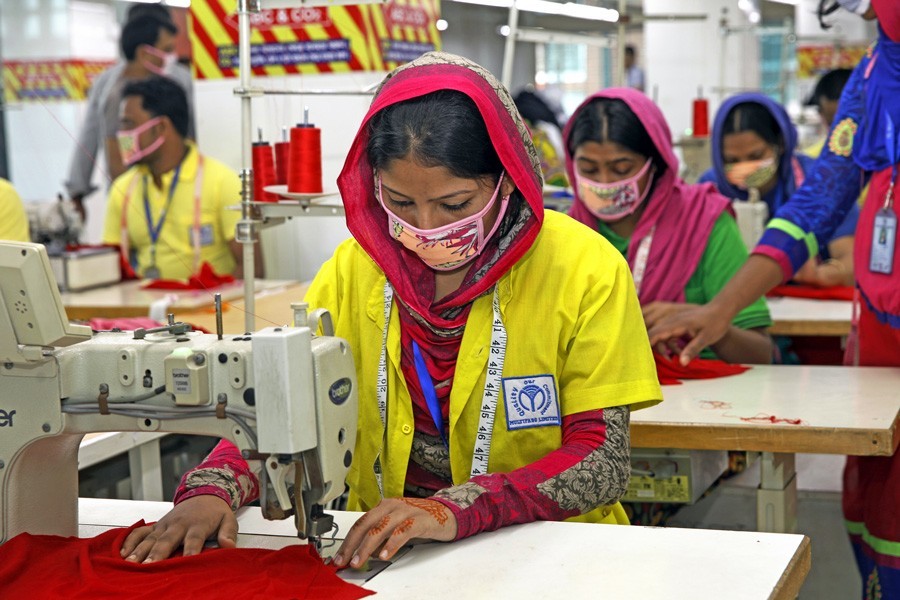The readymade garment (RMG) industry of Bangladesh has witnessed expansion following the Rana Plaza building collapse, according to a latest report, as the number of workers and size of factories increased since then.
Over the period from 2015 to 2020, the annual increase of workers averaged at 1.07 per cent, said the study report titled "Socio- economic Profile of Garment Workers of Bangladesh".
However, many factories were closed down during this period.
Conducted by the Asian Centre for Development (ACD), the study also estimated that the RMG industry employed about 4.22 million workers in 2020.
According to the ACD's first report published in 2015, the number of RMG workers was 4.0 million.
The report also revealed that the ratio of male-female workers changed to 41:59 in 2020 from 35:65 in 2015, indicating that the number of male workers increased faster than female ones during this period.
About 15 per cent of the surveyed factories have foreign staffs - 84 per cent of them are engaged in management positions, followed by technical operations and merchandising and others, according to the report.
Dr AK Enamul Huq, executive director of ACD, revealed the survey findings conducted on 320 garment factories at a virtual programme held on Saturday.
Dhaka Tribune editor Zafar Sobhan moderated the launching programme while labour secretary KM Abdus Salam, EU ambassador and the head of delegation to Bangladesh Rensje Teerink, International Labour Organization Bangladesh country director Tuomo Poutiainen and, Bangladesh Garment Manufacturers and Exporters Association (BGMEA) president Dr Rubana Huq, among others, spoke.
"Despite the fact that many factories were closed down as an aftermath of the Rana Plaza accident, our estimate shows an increase in the number of workers per factory and factories are about 70 per cent larger than that of 2014," the report said.
The total estimated worker in RMG sector is around 4.22 million, of which 1.72 million are male and 2.50 million female.
"Our estimate shows that the number of female workers has grown between 2 to 4 per cent each year, while the number of male workers has grown by 7 to 10 per cent during the same period," the report said.
It identified that the structural changes in the industry from woven factories to knitwear and, adaption of new technology and machinery have squeezed the opportunities for the female workers.
The report also pointed out that the increase in wages was attracting male workers with higher levels of education to seek jobs in the sector.
With changes in the technology, the factories were looking for more skilled workers, which emerged as a great opportunity for the male workers, it added.
According to the findings, there are around 2,200 foreign professionals working at different positions of the RMG sector in Bangladesh.
Some 91 per cent of the BGMEA members are the direct exporters, 6.0 per cent are sub-contractors, and the rest do both jobs.
According to the 2015 ACD survey report, nearly 13 per cent factories were involved in sub-contracting.
In all the grades, average experience for male workers is higher than that of the female ones.
On average, male workers want to continue to work in the sector for 12 years and the number is close to 8 years for female workers.
"One of the reasons for female workers to quit early is to take up greater responsibilities in the family while for male workers, it is to join another job or start a business," the report added.
The study found around 8.3 per cent of the female workers have given birth to a child in a year while about 3.1 per cent of them were eligible and have enjoyed maternity leave with pay.
However, the rest were not eligible to enjoy the leave with pay, it said, suggesting a careful study on the eligibility criteria so that a more humane rule can be framed which could be win-win for both the owners and workers.
Though 87.5 per cent of the surveyed factories had childcare facilities for months, only 11.7 per cent mothers used it.
Commuting distance is an important factor for mothers to bring their child with them to the factories, which resulted in facilities remaining largely unused, it said, recommending development of daycare facilities for children in areas where the workers live.
According to the report, the yearly family income of the workers had increased by 7.0 per cent between 2014 and 2020 while the overall cost of living had risen by 7.0 per cent.
This rise in the cost of living is led by a higher increase in the cost of education, health, personal expenditure and recreation, it added.
The RMG sector workers sent Tk 10.11 billion in remittance per month to the rural economy, according to the findings.


